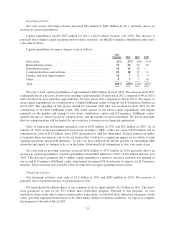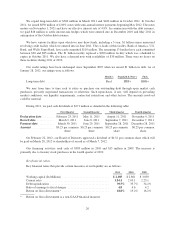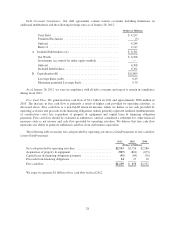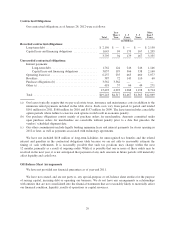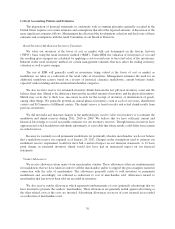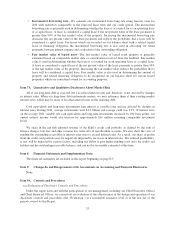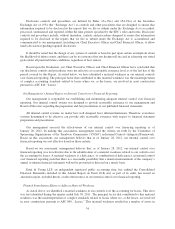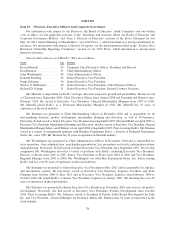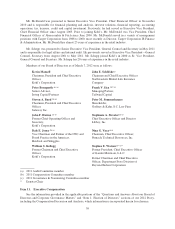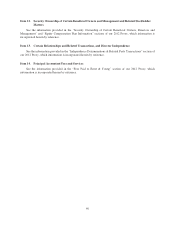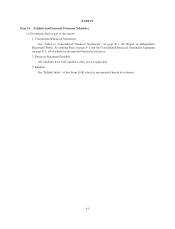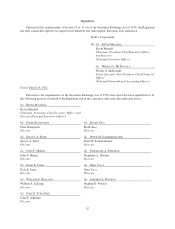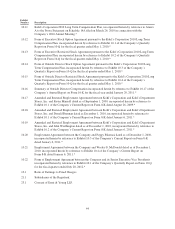Kohl's 2011 Annual Report Download - page 34
Download and view the complete annual report
Please find page 34 of the 2011 Kohl's annual report below. You can navigate through the pages in the report by either clicking on the pages listed below, or by using the keyword search tool below to find specific information within the annual report.Disclosure controls and procedures are defined by Rules 13a-15(e) and 15d-15(e) of the Securities
Exchange Act of 1934 (the “Exchange Act”) as controls and other procedures that are designed to ensure that
information required to be disclosed in the reports that we file or submit under the Exchange Act is recorded,
processed, summarized and reported, within the time periods specified by the SEC’s rules and forms. Disclosure
controls and procedures include, without limitation, controls and procedures designed to ensure that information
required to be disclosed in the reports that we file or submit under the Exchange Act is accumulated and
communicated to our management, including our Chief Executive Officer and Chief Financial Officer, to allow
timely decisions regarding required disclosures.
It should be noted that the design of any system of controls is based in part upon certain assumptions about
the likelihood of future events, and there can be no assurance that any design will succeed in achieving our stated
goals under all potential future conditions, regardless of how remote.
Based upon the Evaluation, our Chief Executive Officer and Chief Financial Officer have concluded that
our disclosure controls and procedures were not effective at a reasonable assurance level as of the last day of the
period covered by this Report. As noted below, we have identified a material weakness in our internal controls
over financial reporting. The principal factor that contributed to this material weakness was the misinterpretation
of complex accounting standards related to leases where we, as the lessee, are involved in asset construction
pursuant to ASC 840, “Leases.”
(b) Management’s Annual Report on Internal Control over Financial Reporting
Our management is responsible for establishing and maintaining adequate internal control over financial
reporting. Our internal control system was designed to provide reasonable assurance to our management and
Board of Directors regarding the preparation and fair presentation of our published financial statements.
All internal control systems, no matter how well designed, have inherent limitations. Therefore, even those
systems determined to be effective can provide only reasonable assurance with respect to financial statement
preparation and presentation.
Our management assessed the effectiveness of our internal control over financing reporting as of
January 28, 2012. In making this assessment, management used the criteria set forth by the Committee of
Sponsoring Organizations of the Treadway Commission (“COSO”) in Internal Control—Integrated Framework.
Based on this assessment, our management believes that as of January 28, 2012, our internal control over
financial reporting was not effective based on those criteria.
Based on our assessment, management believes that, as of January 28, 2012, our internal control over
financial reporting was not effective due to the identification of a material weakness related to our controls over
the accounting for leases. A material weakness is a deficiency, or combination of deficiencies, in internal control
over financial reporting such that there is a reasonable possibility that a material misstatement of the company’s
annual or interim financial statements will not be prevented or detected on a timely basis.
Ernst & Young LLP, an independent registered public accounting firm, has audited the Consolidated
Financial Statements included in this Annual Report on Form 10-K and, as part of its audit, has issued an
attestation report, included herein, on the effectiveness of our internal control over financial reporting.
Planned Remediation Efforts to Address Material Weakness
As stated above, we identified a material weakness in our controls over the accounting for leases. This error
was first identified during the quarter ended July 30, 2011. The principal factor that contributed to this material
weakness was the misinterpretation of complex standards related to leases where we, as the lessee, are involved
in asset construction pursuant to ASC 840, “Leases.” This material weakness resulted in a number of errors in
34



